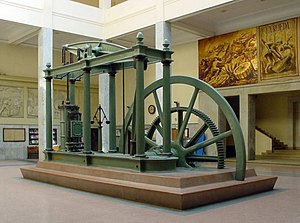
Back محرك واط البخاري Arabic Màquina de Watt Catalan Watt-dampmaskine Danish Máquina de vapor de Watt Spanish Machine de Watt French מנוע הקיטור של ואט HE वाट का वाष्प इंजन Hindi Macchina a vapore di James Watt Italian 와트 증기기관 Korean واټ بړاس ماشين Pashto/Pushto

The Watt steam engine design was an invention of James Watt that became synonymous with steam engines during the Industrial Revolution, and it was many years before significantly new designs began to replace the basic Watt design.
The first steam engines, introduced by Thomas Newcomen in 1712, were of the "atmospheric" design. At the end of the power stroke, the weight of the object being moved by the engine pulled the piston to the top of the cylinder as steam was introduced. Then the cylinder was cooled by a spray of water, which caused the steam to condense, forming a partial vacuum in the cylinder. Atmospheric pressure on the top of the piston pushed it down, lifting the work object. James Watt noticed that it required significant amounts of heat to warm the cylinder back up to the point where steam could enter the cylinder without immediately condensing. When the cylinder was warm enough that it became filled with steam the next power stroke could commence.
Watt realised that the heat needed to warm the cylinder could be saved by adding a separate condensing cylinder. After the power cylinder was filled with steam, a valve was opened to the secondary cylinder, allowing the steam to flow into it and be condensed, which drew the steam from the main cylinder causing the power stroke. The condensing cylinder was water cooled to keep the steam condensing. At the end of the power stroke, the valve was closed so the power cylinder could be filled with steam as the piston moved to the top. The result was the same cycle as Newcomen's design, but without any cooling of the power cylinder which was immediately ready for another stroke.
Watt worked on the design over a period of several years, introducing the condenser, and introducing improvements to practically every part of the design. Notably, Watt performed a lengthy series of trials on ways to seal the piston in the cylinder, which considerably reduced leakage during the power stroke, preventing power loss. All of these changes produced a more reliable design which used half as much coal to produce the same amount of power.[1]
The new design was introduced commercially in 1776, with the first example sold to the Carron Company ironworks. Watt continued working to improve the engine, and in 1781 introduced a system using a sun and planet gear to turn the linear motion of the engines into rotary motion. This made it useful not only in the original pumping role, but also as a direct replacement in roles where a water wheel would have been used previously. This was a key moment in the industrial revolution, since power sources could now be located anywhere instead of, as previously, needing a suitable water source and topography. Watt's partner Matthew Boulton began developing a multitude of machines that made use of this rotary power, developing the first modern industrialized factory, the Soho Foundry, which in turn produced new steam engine designs. Watt's early engines were like the original Newcomen designs in that they used low-pressure steam, and all of the power was produced by atmospheric pressure. When, in the early 1800s, other companies introduced high-pressure steam engines, Watt was reluctant to follow suit due to safety concerns.[2] Wanting to improve on the performance of his engines, Watt began considering the use of higher-pressure steam, as well as designs using multiple cylinders in both the double-acting concept and the multiple-expansion concept. These double-acting engines required the invention of the parallel motion, which allowed the piston rods of the individual cylinders to move in straight lines, keeping the piston true in the cylinder, while the walking beam end moved through an arc, somewhat analogous to a crosshead in later steam engines.
- ^ Ayres, Robert (1989). "Technological Transformations and Long Waves" (PDF). p. 13.
- ^ Dickinson, Henry Winram (1939). A Short History of the Steam Engine. Cambridge University Press. p. 87. ISBN 978-1-108-01228-7.